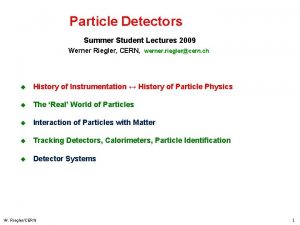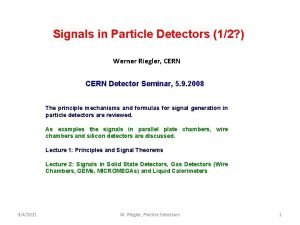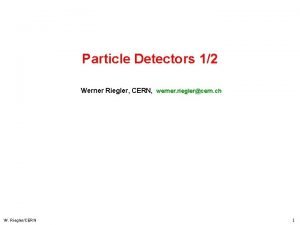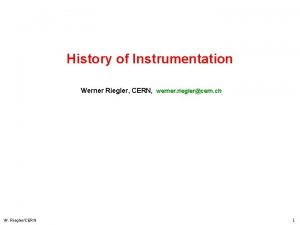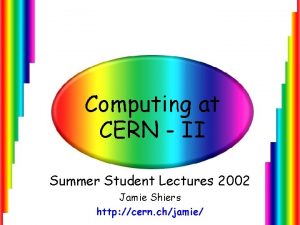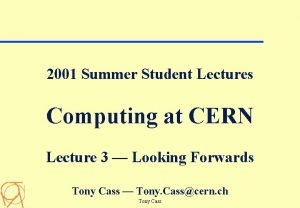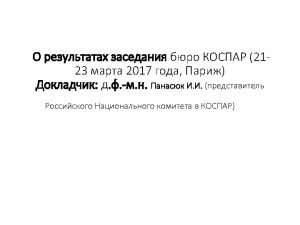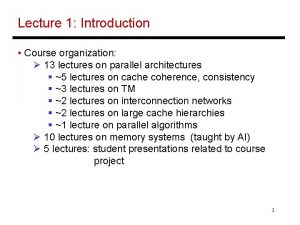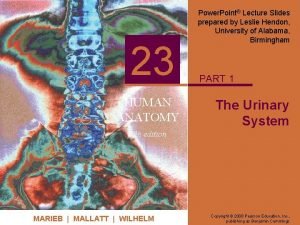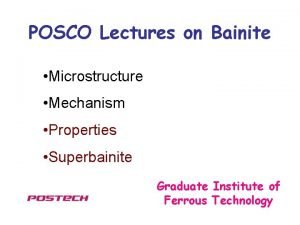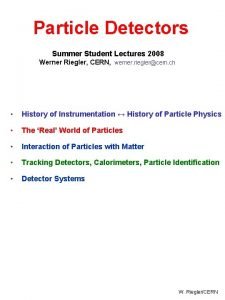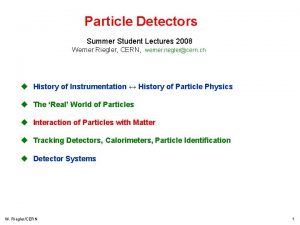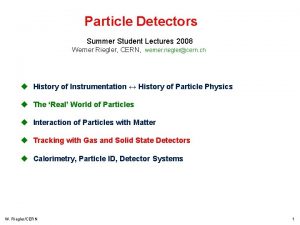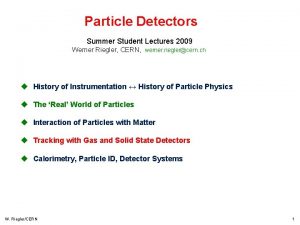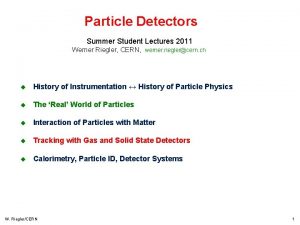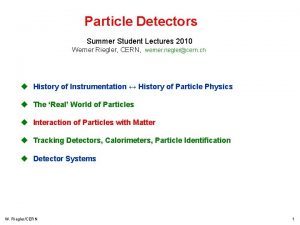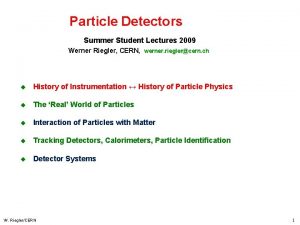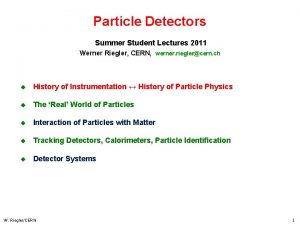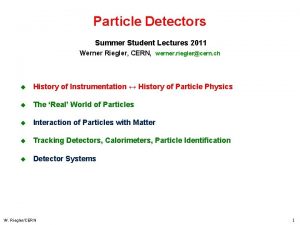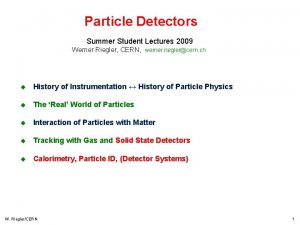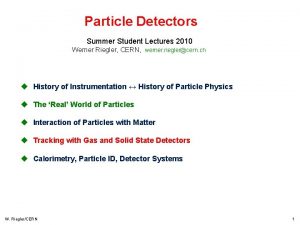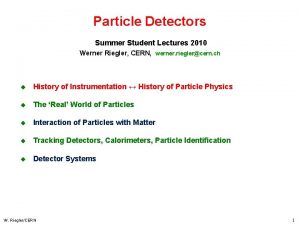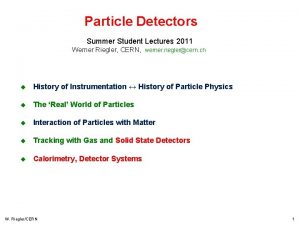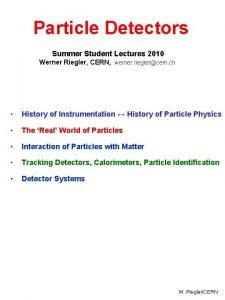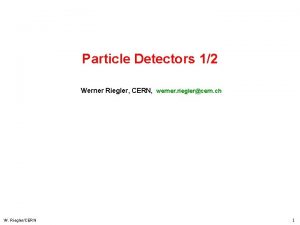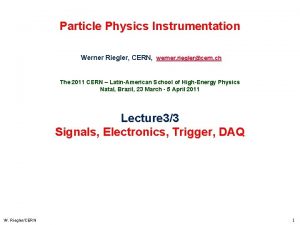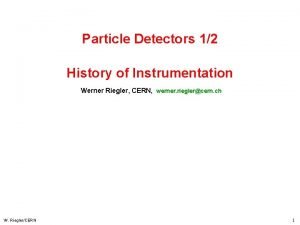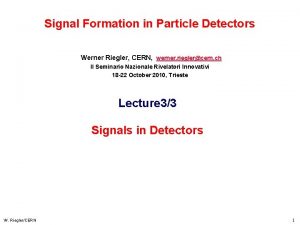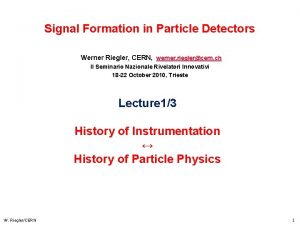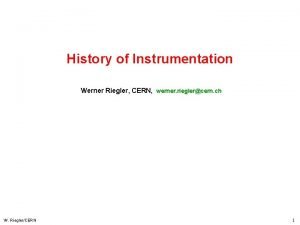Particle Detectors Summer Student Lectures 2008 Werner Riegler







![Interaction of Particles with Matter Target material: mass A, Z 2, density [g/cm 3], Interaction of Particles with Matter Target material: mass A, Z 2, density [g/cm 3],](https://slidetodoc.com/presentation_image_h2/9e4bf32df1dbef5c8916780adb5b3cbd/image-8.jpg)















































- Slides: 55

Particle Detectors Summer Student Lectures 2008 Werner Riegler, CERN, werner. riegler@cern. ch u History of Instrumentation ↔ History of Particle Physics u The ‘Real’ World of Particles u Interaction of Particles with Matter u Tracking Detectors, Calorimeters, Particle Identification u Detector Systems W. Riegler/CERN 1

Particle Detectors Detector-Physics: Precise knowledge of the processes leading to signals in particle detectors is necessary. The detectors are nowadays working close to the limits of theoretically achievable measurement accuracy – even in large systems. Due to available computing power, detectors can be simulated to within 510% of reality, based on the fundamental microphysics processes (atomic and nuclear crossections). W. Riegler/CERN 2

Particle Detector Simulation Electric Fields in a Micromega Detector Very accurate simulations of particle detectors are possible due to availability of Finite Element simulation programs and computing power. Follow every single electron by applying first principle laws of physics. Electrons avalanche multiplication W. Riegler/CERN 3

Particle Detector Simulation I) C. Moore’s Law: Computing power doubles 18 months. II) W. Riegler’s Law: The use of brain for solving a problem is inversely proportional to the available computing power. I) + II) =. . . Knowing the basics of particle detectors is essential … W. Riegler/CERN 4

Interaction of Particles with Matter Any device that is to detect a particle must interact with it in some way almost … In many experiments neutrinos are measured by missing transverse momentum. E. g. e+e- collider. Ptot=0, If the Σ pi of all collision products is ≠ 0 neutrino escaped. Claus Grupen, Particle Detectors, Cambridge University Press, Cambridge 1996 (455 pp. ISBN 0 -521 -55216 -8) W. Riegler/CERN 5

Electromagnetic Interaction of Particles with Matter Z 2 electrons, q=-e 0 M, q=Z 1 e 0 Interaction with the atomic electrons. The incoming particle loses energy and the atoms are excited or ionized. 9/12/2021 Interaction with the atomic nucleus. The particle is deflected (scattered) causing multiple scattering of the particle in the material. During this scattering a Bremsstrahlung photon can be emitted. In case the particle’s velocity is larger than the velocity of light in the medium, the resulting EM shockwave manifests itself as Cherenkov Radiation. When the particle crosses the boundary between two media, there is a probability of the order of 1% to produced and X ray photon, called Transition radiation. W. Riegler, Particle Detectors 6

Interaction of Particles with Matter F b x While the charged particle is passing another charged particle, the Coulomb Force is acting, resulting in momentum transfer The relativistic form of the transverse electric field doesn’t change the momentum transfer. The transverse field is stronger, but the time of action is shorter The transferred energy is then The incoming particle transfer energy only (mostly) to the atomic electrons ! 9/12/2021 W. Riegler, Particle Detectors 7
![Interaction of Particles with Matter Target material mass A Z 2 density gcm 3 Interaction of Particles with Matter Target material: mass A, Z 2, density [g/cm 3],](https://slidetodoc.com/presentation_image_h2/9e4bf32df1dbef5c8916780adb5b3cbd/image-8.jpg)
Interaction of Particles with Matter Target material: mass A, Z 2, density [g/cm 3], Avogadro number NA A gramm NA Atoms: Number of atoms/cm 3 Number of electrons/cm 3 na =NA /A [1/cm 3] ne =NA Z 2/A [1/cm 3] With E(b) db/b = -1/2 d. E/E Emax= E(bmin) Emin = E(bmax) Emin I (Ionization Energy) 9/12/2021 W. Riegler, Particle Detectors 8

Relativistic Collision Kinematics, Emax θ φ 1) 2) 1+2) 9/12/2021 W. Riegler, Particle Detectors 9

Classical Scattering on Free Electrons 1/ This formula is up to a factor 2 and the density effect identical to the precise QM derivation Bethe Bloch Formula Electron Spin W. Riegler/CERN Density effect. Medium is polarized Which reduces the log. rise. 10

Small energy loss Fast Particle Cosmis rays: d. E/dx α Z 2 Small energy loss Fast particle Pion Large energy loss Slow particle Discovery of muon and pion Pion W. Riegler/CERN Kaon 11

Bethe Bloch Formula Für Z>1, I 16 Z 0. 9 e. V For Large the medium is being polarized by the strong transverse fields, which reduces the rise of the energy loss density effect Characteristics of the energy loss as a function of the particle velocity ( ) 1/ At large Energy Transfers (delta electrons) the liberated electrons can leave the material. In reality, Emax must be replaced by Ecut and the energy loss reaches a plateau (Fermi plateau). The specific Energy Loss 1/ρ d. E/dx • firts decreaes as 1/ 2 • increases with ln for =1 • is independent of M (M>>me) • is proportional to Z 12 of the incoming particle. • is independent of the material (Z/A const) • shows a pleateau at large (>>100) • d. E/dx 1 -2 x ρ [g/cm 3] Me. V/cm W. Riegler/CERN Energy Loss by Excitation and Ionization 12

Bethe Bloch Formula, a few Numbers: For Z 0. 5 A 1/ d. E/dx 1. 4 Me. V cm 2/g for ßγ 3 1/ Example : Iron: Thickness = 100 cm; ρ = 7. 87 g/cm 3 d. E ≈ 1. 4 * 100* 7. 87 = 1102 Me. V A 1 Ge. V Muon can traverse 1 m of Iron This number must be multiplied with ρ [g/cm 3] of the Material d. E/dx [Me. V/cm] W. Riegler/CERN Energy Loss by Excitation and Ionization 13

Energy Loss as a Function of the Momentum Energy loss depends on the particle velocity and is ≈ independent of the particle’s mass M. The energy loss as a function of particle Momentum P= Mcβγ IS however depending on the particle’s mass By measuring the particle momentum (deflection in the magnetic field) and measurement of the energy loss on can measure the particle mass Particle Identification ! W. Riegler/CERN Energy Loss by Excitation and Ionization 14

Energy Loss as a Function of the Momentum Measure momentum by curvature of the particle track. Find d. E/dx by measuring the deposited charge along the track. Particle ID W. Riegler/CERN 15

Range of Particles in Matter Particle of mass M and kinetic Energy E 0 enters matter and looses energy until it comes to rest at distance R. » Independent of the material Bragg Peak: For >3 the energy loss is constant (Fermi Plateau) If the energy of the particle falls below =3 the energy loss rises as 1/ 2 Towards the end of the track the energy loss is largest Cancer Therapy. W. Riegler/CERN Energy Loss by Excitation and Ionization 16

Range of Particles in Matter Average Range: Towards the end of the track the energy loss is largest Bragg Peak Cancer Therapy Carbon Ions 330 Me. V Relative Dose (%) Photons 25 Me. V Depth of Water (cm) W. Riegler/CERN Energy Loss by Excitation and Ionization 17

Luis Alvarez used the attenuation of muons to look for chambers in the Second Giza Pyramid Muon Tomography He proved that there are no chambers present. 9/12/2021 W. Riegler, Particle 18

Intermezzo: Crossection : Material with Atomic Mass A and density contains n Atoms/cm 3 E. g. Atom (Sphere) with Radius R: Atomic Crossection = R 2 A volume with surface F and thickness dx contains N=n. Fdx Atoms. The total ‘surface’ of atoms in this volume is N . The relative area is p = N /F = NA /A dx = Probability that an incoming particle hits an atom in dx. F dx What is the probability P that a particle hits an atom between distance x and x+dx ? P = probability that the particle does NOT hit an atom in the m=x/dx material layers and that the particle DOES hit an atom in the mth layer Mean free path Average number of collisions/cm 9/12/2021 19

Intermezzo: Differential Crossection: Crossection for an incoming particle of energy E to lose an energy between E’ and E’+d. E’ Total Crossection: Probability P(E) that an incoming particle of Energy E loses an energy between E’ and E’+d. E’ in a collision: Average number of collisions/cm causing an energy loss between E’ and E’+d. E’ Average energy loss/cm: 9/12/2021 W. Riegler, Particle 20

Fluctuation of Energy Loss Up to now we have calculated the average energy loss. The energy loss is however a statistical process and will therefore fluctuate from event to event. x=0 x=D E- E XX XX X X X XXX X P( ) = ? Probability that a particle loses an energy when traversing a material of thickness D We have see earlier that the probability of an interaction ocuring between distance x and x+dx is exponentially distributed

Probability for n Interactions in D We first calculate the probability to find n interactions in D, knowing that the probability to find a distance x between two interactions is P(x)dx = 1/ exp(-x/ ) dx with = A/ NA

Probability for n Interactions in D For an interaction with a mean free path of , the probability for n interactions on a distance D is given by àPoisson Distribution ! If the distance between interactions is exponentially distributed with an mean free path of λ the number of interactions on a distance D is Poisson distributed with an average of n=D/λ. How do we find the energy loss distribution ? If f(E) is the probability to lose the energy E’ in an interaction, the probability p(E) to lose an energy E over the distance D ?

Fluctuations of the Energy Loss d (E, E’)/d. E’/ (E) Probability f(E) for loosing energy between E’ and E’+d. E’ in a single interaction is given by the differential crossection d (E, E’)/d. E’/ (E) which is given by the Rutherford crossection at large energy transfers Excitation and ionization Scattering on free electrons P(E, ) W. Riegler/CERN Energy Loss by Excitation and Ionization 24

Landau Distribution P( ): Probability for energy loss in matter of thickness D. Landau distribution is very asymmetric. Average and most probable energy loss must be distinguished ! Measured Energy Loss is usually smaller that the real energy loss: 3 Ge. V Pion: E’max = 450 Me. V A 450 Me. V Electron usually leaves the detector. W. Riegler/CERN Energy Loss by Excitation and Ionization 25

Landau Distribution LANDAU DISTRIBUTION OF ENERGY LOSS: Counts 4 cm Ar-CH 4 (95 -5) 5 bars 6000 PARTICLE IDENTIFICATION Requires statistical analysis of hundreds of samples Counts 15 Ge. V/c 6000 protons electrons N = 460 i. p. FWHM~250 i. p. 4000 2000 0 0 0 500 1000 N (i. p. ) 0 For a Gaussian distribution: N ~ 21 i. p. FWHM ~ 50 i. p. 500 1000 N (i. p) I. Lehraus et al, Phys. Scripta 23(1981)727 W. Riegler/CERN Energy Loss by Excitation and Ionization 26

Particle Identification Measured energy loss ‘average’ energy loss In certain momentum ranges, particles can be identified by measuring the energy loss. W. Riegler/CERN Energy Loss by Excitation and Ionization 27

Bremsstrahlung A charged particle of mass M and charge q=Z 1 e is deflected by a nucleus of charge Ze which is partially ‘shielded’ by the electrons. During this deflection the charge is ‘accelerated’ and it therefore radiated Bremsstrahlung. Z 2 electrons, q=-e 0 M, q=Z 1 e 0 9/12/2021 W. Riegler, Particle 28

Bremsstrahlung, Classical A charged particle of mass M and charge q=Z 1 e is deflected by a nucleus of Charge Ze. Because of the acceleration the particle radiated EM waves energy loss. Coulomb-Scattering (Rutherford Scattering) describes the deflection of the particle. Maxwell’s Equations describe the radiated energy for a given momentum transfer. d. E/dx W. Riegler/CERN 29

Bremsstrahlung, QM Proportional to Z 2/A of the Material. Proportional to Z 14 of the incoming particle. Proportional to of the material. Proportional 1/M 2 of the incoming particle. Proportional to the Energy of the Incoming particle E(x)=Exp(-x/X 0) – ‘Radiation Length’ X 0 M 2 A/ ( Z 14 Z 2) X 0: Distance where the Energy E 0 of the incoming particle decreases E 0 Exp(-1)=0. 37 E 0. W. Riegler/CERN 30

Critical Energy For the muon, the second lightest particle after the electron, the critical energy is at 400 Ge. V. The EM Bremsstrahlung is therefore only relevant for electrons at energies of past and present detectors. Electron Momentum 5 50 500 Me. V/c Critical Energy: If d. E/dx (Ionization) = d. E/dx (Bremsstrahlung) Myon in Copper: Electron in Copper: W. Riegler/CERN p 400 Ge. V p 20 Me. V 31

Pair Production, QM For E >>mec 2=0. 5 Me. V : = 9/7 X 0 Average distance a high energy photon has to travel before it converts into an e+ e- pair is equal to 9/7 of the distance that a high energy electron has to travel before reducing it’s energy from E 0 to E 0*Exp(-1) by photon radiation. W. Riegler/CERN 32

Bremsstrahlung + Pair Production EM Shower W. Riegler/CERN 33

Multiple Scattering Statistical (quite complex) analysis of multiple collisions gives: Probability that a particle is defected by an angle after travelling a distance x in the material is given by a Gaussian distribution with sigma of: X 0. . . Radiation length of the material Z 1. . . Charge of the particle p. . . Momentum of the particle W. Riegler/CERN 34

Multiple Scattering Magnetic Spectrometer: A charged particle describes a circle in a magnetic field: Limit Multiple Scattering W. Riegler/CERN 35

Multiple Scattering W. Riegler/CERN 36

Multiple Scattering ATLAS Muon Spectrometer: N=3, sig=50 um, P=1 Te. V, L=5 m, B=0. 4 T ∆p/p ~ 8% for the most energetic muons at LHC W. Riegler/CERN 37

Cherenkov Radiation If we describe the passage of a charged particle through material of dielectric permittivity (using Maxwell’s equations) the differential energy crossection is >0 if the velocity of the particle is larger than the velocity of light in the medium is N is the number of Cherenkov Photons emitted per cm of material. The expression is in addition proportional to Z 12 of the incoming particle. The radiation is emitted at the characteristic angle c , that is related to the refractive index n and the particle velocity by M, q=Z 1 e 0 38

Cherenkov Radiation 39

Ring Imaging Cherenkov Detector (RICH) There are only ‘a few’ photons per event one needs highly sensitive photon detectors to measure the rings ! W. Riegler/CERN 40

LHCb RICH W. Riegler/CERN 41

Transition Radiation Z 2 electrons, q=-e 0 M, q=Z 1 e 0 When the particle crosses the boundary between two media, there is a probability of the order of 1% to produced and X ray photon, called Transition radiation. 9/12/2021 42

Transition Radiation W. Riegler/CERN 43

Electromagnetic Interaction of Particles with Matter Ionization and Excitation: Charged particles traversing material are exciting and ionizing the atoms. The average energy loss of the incoming particle by this process is to a good approximation described by the Bethe Bloch formula. The energy loss fluctuation is well approximated by the Landau distribution. Multiple Scattering and Bremsstrahlung: The incoming particles are scattering off the atomic nuclei which are partially shielded by the atomic electrons. Measuring the particle momentum by deflection of the particle trajectory in the magnetic field, this scattering imposes a lower limit on the momentum resolution of the spectrometer. The deflection of the particle on the nucleus results in an acceleration that causes emission of Bremsstrahlungs-Photons. These photons in turn produced e+e- pairs in the vicinity of the nucleus, which causes an EM cascade. This effect depends on the 2 nd power of the particle mass, so it is only relevant for electrons. 9/12/2021 44

Electromagnetic Interaction of Particles with Matter Cherenkov Radiation: If a particle propagates in a material with a velocity larger than the speed of light in this material, Cherenkov radiation is emitted at a characteristic angle that depends on the particle velocity and the refractive index of the material. Transition Radiation: If a charged particle is crossing the boundary between two materials of different dielectric permittivity, there is a certain probability for emission of an X-ray photon. The strong interaction of an incoming particle with matter is a process which is important for Hadron calorimetry and will be discussed later. 9/12/2021 45

Electromagnetic Interaction of Particles with Matter Z 2 electrons, q=-e 0 M, q=Z 1 e 0 Now that we know all the Interactions we can talk about Detectors ! Interaction with the atomic electrons. The incoming particle loses energy and the atoms are excited or ionized. 9/12/2021 Interaction with the atomic nucleus. The particle is deflected (scattered) causing multiple scattering of the particle in the material. During this scattering a Bremsstrahlung photon can be emitted. In case the particle’s velocity is larger than the velocity of light in the medium, the resulting EM shockwave manifests itself as Cherenkov Radiation. When the particle crosses the boundary between two media, there is a probability of the order of 1% to produced and X ray photon, called Transition radiation. 46

Now that we know all the Interactions we can talk about Detectors ! W. Riegler/CERN 47

Detectors based on registration of Ionization: Tracking in Gas and Solid State Detectors Charged particles leave a trail of ions (and excited atoms) along their path: Electron-Ion pairs in gases and liquids, electron hole pairs in solids. The photons emitted by the excited atoms can be detected with photon detectors like photomultipliers or semiconductor photon detectors. The produced charges can be registered Position measurement Tracking Detectors. Cloud Chamber: Charges create drops photography. Bubble Chamber: Charges create bubbles photography. Emulsion: Charges ‘blacked’ the film. Gas and Solid State Detectors: Moving Charges (electric fields) induce electronic signals on metallic electrons that can be read by dedicated electronics. àIn solid state detectors the charge created by the incoming particle is sufficient. àIn gas detectors (e. g. wire chamber) the charges are internally multiplied in order to provide a measurable signal. W. Riegler/CERN Tracking Detectors 48

Principle of signal induction by moving charges: The electric field of the charge must be calculated with the boundary condition that the potential φ=0 at z=0. A point charge q at a distance z 0 Above a grounded metal plate ‘induces’ a surface charge. The total induced charge on the surface is –q. Different positions of the charge result in different charge distributions. The total induced charge stays –q. q For this specific geometry the method of images can be used. A point charge –q at distance –z 0 satisfies the boundary condition electric field. q The resulting charge density is (x, y) = 0 Ez(x, y) -q (x, y)dxdy = -q -q I=0 W. Riegler/CERN Signal induction by moving charges 49

Principle of signal induction by moving charges: If we segment the grounded metal plate and if we ground the individual strips the charge density doesn’t change. q V The charge induced on the individual strips is now depending on the position z 0 of the charge. If the charge is moving there are currents flowing between the strips and gorund. -q The movement of the charge induces a current. -q I 1(t) I 2(t) I 3(t) I 4(t) z 0(t)=z 1 -v*t W. Riegler/CERN Signal induction by moving charges 50

In order to calculate the signals the Poisson equation must be calculated for all different positions of the charge q difficult task. Theorem (1) (Reciprocity theorem, Ramotheorem): The current induced on a grounded electrode (n) by the movement of a charge q along a trajectory x(t) can be calculated the following way: One removes the charge q and brings electrode (n) to potential V 0 while keeping all the other electrodes at ground potential. This defined an electric field En(x) (‘Weighting field’ of electrode n). The induced current is then W. Riegler/CERN Signal induction by moving charges 51

I 2 Example: Elektron-Ion pair in gas z E 1=V 0/D E 2=-V 0/D Z=D E -q, ve q, v. I Z=z 0 Z=0 I 1= -(-q)/V 0*(V 0/D)*ve - q/V 0 (V 0/D) (-v. I) = q/D*ve+q/D*v. I I 2=-I 1 The induced current is proportional to the velocity of the charges. I 1 Te TI t Qtot 1= I 1 dt = q/D*ve Te + q/D*v. I*TI = q/D*ve*(D-z 0)/ve + q/D*v. I*z 0/v. I = q(D-z 0)/D + qz 0/D = qe+q. I=q The induced charge depends on the position from where the charge starts moving. The total induced charge on a specific electrode, once all the charges have arrived at the electrodes, is equal to the charge that has arrived at this specific electrode. W. Riegler/CERN Signal induction by moving charges 52

Theorem (2): In case the electrodes are not grounded but connectd by arbitrary active or passive elements one first calculates the currents induced on the grounded electrodes and places them as ideal current sources on the equivalent circuit of the electrodes. V 2 R Z=D q, v 1 -q, v 2 Z=z 0 R C Z=0 V 1 W. Riegler/CERN I 2 R I 1 R Signal induction by moving charges 53

The induced signals are readout by dedicated electronics. The noise of an amplifier determines whether the signal can be registered. Signal/Noise >>1 The noise is characterized by the ‘Equivalent Noise Charge (ENC)’ = Charge signal at the input that produced an output signal equal to the noise. ENC of very good amplifiers can be as low as 50 e -, typical numbers are ~ 1000 e-. I=2. 9 e. V 2. 5 x 106 e/h pairs/cm In order to register a signal, the registered charge must be q >> ENC i. e. typically q>>1000 e-. Gas Detector: q=80 e- /cm too small. Solid state detectors have 1000 x more density and factor 5 -10 less ionization energy. àPrimary charge is 104 -105 times larger than is gases. 1/ Gas detectors need internal amplification in order to be sensitive to single particle tracks. ßγ W. Riegler/CERN Without internal amplification they can only be used for a large number of particles that arrive at the same time (ionization chamber). 54

By using thin wires, the electric fields close to the wires are very strong (e. g. 100 -300 k. V/cm). In these large electric fields, the electrons gain enough energy to ionize the gas themselves Avalanche a primary electron produces 103 -106 electrons measurable signal. W. Riegler/CERN 55
 Werner riegler
Werner riegler Werner riegler cern
Werner riegler cern Werner riegler cern
Werner riegler cern Werner riegler
Werner riegler Cern summer student lectures
Cern summer student lectures Cern summer school lectures
Cern summer school lectures Medical emergency student lectures
Medical emergency student lectures Hematology
Hematology 2008 2008
2008 2008 Harald riegler
Harald riegler Feature vectors
Feature vectors Streaming current detectors
Streaming current detectors Chromatography mobile phase and stationary phase
Chromatography mobile phase and stationary phase Feature detectors
Feature detectors Vhv voltage detectors
Vhv voltage detectors Where are feature detectors located
Where are feature detectors located Giant wave detectors murmurs universe
Giant wave detectors murmurs universe Yodsawalai chodpathumwan
Yodsawalai chodpathumwan Frontier detectors for frontier physics
Frontier detectors for frontier physics Photo detectors
Photo detectors Feature detectors ap psychology
Feature detectors ap psychology Gravitational wave hear murmurs universe
Gravitational wave hear murmurs universe What is thermal detector
What is thermal detector Nuclear detectors
Nuclear detectors Utilities and energy lectures
Utilities and energy lectures Rick trebino lectures
Rick trebino lectures Comsats virtual campus lectures
Comsats virtual campus lectures Bureau of lectures
Bureau of lectures Hegel aesthetics lectures on fine art
Hegel aesthetics lectures on fine art Rotating anode
Rotating anode Molecular biology lectures
Molecular biology lectures Ota core curriculum
Ota core curriculum Uva powerpoint template
Uva powerpoint template Stratog online lectures
Stratog online lectures 13 lectures
13 lectures Oral communication 3 lectures text
Oral communication 3 lectures text Theory of translation lectures
Theory of translation lectures Theory of translation lectures
Theory of translation lectures Introduction to web engineering
Introduction to web engineering Lectures paediatrics
Lectures paediatrics Hugh blair lectures on rhetoric
Hugh blair lectures on rhetoric Slagle lecture
Slagle lecture Nuclear medicine lectures
Nuclear medicine lectures Cs106b lectures
Cs106b lectures Radio astronomy lectures
Radio astronomy lectures Anatomy lectures powerpoint
Anatomy lectures powerpoint Ludic space
Ludic space Bhadeshia lectures
Bhadeshia lectures C programming lectures
C programming lectures Digital logic design lectures
Digital logic design lectures Power system lectures
Power system lectures Do words have power
Do words have power Pathology lectures for medical students
Pathology lectures for medical students Data mining lectures
Data mining lectures Reinforcement learning lectures
Reinforcement learning lectures Theory of translation lectures
Theory of translation lectures
